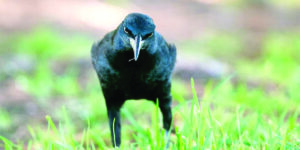By Dr. Beth Leermakers
The association between ravens and Halloween makes sense, given that many cultures consider ravens to be symbols of illness, death or a bad omen. Because ravens eat carrion (dead animals) — and feasted on the remains of soldiers killed in battle — Celtic people associated them with death, war and the battlefield.
Germans believed that ravens could locate the souls of the dead and that witches rode on the birds’ backs instead of on broomsticks. Ravens sit on perches near witches, seeing everything that happens. These birds served as witches’ messengers, carrying magic across great distances and gathering secrets to bring back to the witches.
As Halloween approaches, let’s take a look at these magical, far-flying birds and the differences between them, crows and grackles.

Photo courtesy of the National Audubon Society
Common ravens. Members of the Corvus family (along with crows, jays and magpies), common ravens are large (about the size of a red-tailed hawk), all-black birds with hoarse, cawing voices. A group of ravens is called an “unkindness.” With their large wingspan (up to 4.7 feet), ravens are excellent, acrobatic fliers (on par with falcons and hawks). Ravens may fly 30 to 40 miles per day from their roost to their daytime feeding areas. These birds live in forested and mountainous areas in the western third of the U.S. and parts of the southeast, mid-Atlantic and New England; they are not found in North Texas.
Ravens are highly intelligent birds that make and use tools, plan for the future, barter and even play games like hide-and-seek. Ravens can mimic animal and bird calls and even human voices.
American Crows. Also members of the Corvus family, crows (almost as large as a chicken) are smaller than ravens. A group of crows is called a murder. These all-black birds are widespread across nearly all of the U.S. and parts of Canada. They are commonly seen in North Texas during all seasons. In the winter large numbers of American Crows (a few hundred up to two million) congregate to sleep in communal roosts. Like ravens, crows are highly intelligent birds. They are crafty creatures who steal food from other animals and follow adult birds to find their nests. Crows are known for making and using tools, such as using a cup to carry water to a bowl of dry mash. Crows perform almost as well as ravens on intelligence tests. Crows have a remarkable memory for human faces — and whether a particular person is a threat.
How to tell the difference between ravens and crows:
• Ravens often travel in pairs, while crows are seen in larger groups.
• The crow’s tail feathers are all the same length, so their in-flight, open tail looks like a fan. Ravens have longer feathers in the middle of their tails, so their tail appears wedge-shaped when open.
• Ravens ride the thermals, soaring and gliding, while crows flap their wings more often.
• Ravens have bigger, more curved beaks than crows.
• Crows caw and purr (especially when flying), while ravens croak like a frog.
Grackles. Grackles are part of the Quiscalus family (blackbirds and orioles). A group of grackles is called a plague. Grackles are robin-sized, about half the size of crows. They have smaller beaks and narrower wings than crows. Grackles have black and iridescent blue feathers (the latter especially on their head). Their calls sound like a rusty gate hinge. Grackles are commonly found in North Texas year-round. Big flocks fly overhead in the evening, heading for major communal roosts, especially from late summer through winter.
Unlike ravens and crows, grackles are not known for their intelligence. However, they have plenty of “survival smarts.” Grackles are resourceful foragers that follow plows to catch invertebrates and mice, wade into water to catch small fish, pick leeches off the legs of turtles, steal worms from American Robins and raid nests. Common Grackles spread their wings and let ants crawl on their body and feathers (“anting”). The ants secrete formic acid, the chemical in their stings, and this may rid the bird of harmful parasites.
This Halloween, you won’t encounter any real ravens. But in other parts of the country, birds are plotting how to steal candy from unsuspecting trick-or-treaters.
